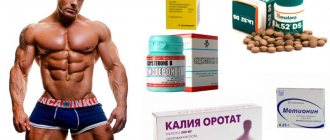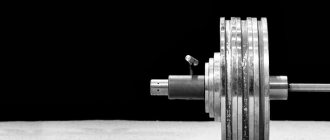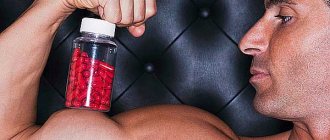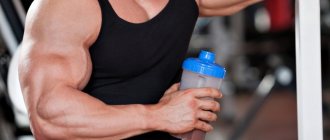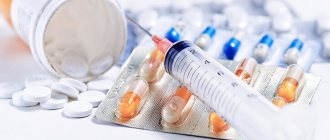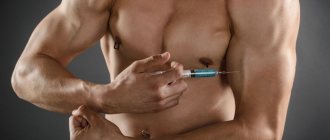Steroids (more precisely, steroid hormones) were so named because their common precursor is cholesterol. The most important representatives of steroid hormones are aldosterone, cortisol, testosterone, estradiol, progesterone.
Steroid hormones are lipophilic (that is, fat-soluble), so they are bound to transport proteins in the blood. Only a small part of steroids is found in the blood in free form, but it is this free fraction that has biological activity, since only free hormone penetrates the plasma membrane of cells. In the cytoplasm or in the cell nucleus, the hormone interacts with a specific receptor. The hormone-receptor complex then binds to a specific region of DNA and can stimulate or inhibit the transcription of certain genes.
Let's make some clarifications: to stimulate means to start, and to inhibit means to slow down, transcription means “reading” (what is written in the gene is what the hormone receptor complex counts). The action of the hormone for several hours leads to changes in the level of specific RNA and proteins. The majority of steroid hormone molecules present in the blood never interact with target cells and are ultimately inactivated and eliminated from the body.
What are anabolic steroids - article about steroids
While some bodybuilders sit on special diets and sweat in the gym, gaining muscle mass for a long time and painfully, others, lazier, turn to banned anabolic-androgenic steroids for help. In this situation, anabolic steroids help build muscle mass, and androgens play a role in the development of male sexual characteristics.
The use of such drugs develops in a person tolerance to the substance, and therefore a habit. In this case, the person will need addiction treatment and rehabilitation assistance. Other steroids like cortisol, estrogen, progesterone do not help build muscle mass, so they are not harmful.
Mineralocorticoids
Produced by the zona glomerulosa of the adrenal cortex.
Preparations:
- Deoxycorticosterone acetate
- Deoxycorticosterone trimethyl acetate
- Fluorohydrocortisone acetate (has an anti-inflammatory effect)
Increase the reabsorption of sodium and water in the renal tubules, increase the excretion of Ca, K, Mg. Sodium retention leads to increased sodium concentration in the extracellular fluid, which in turn leads to water retention and the development of edema. The sensitivity of blood vessels to the action of vasodilators increases. Blood pressure rises.
Indications:
- Addison's disease
- Myasthenia gravis
- Adynamia
- Hypotension
Contraindications:
- Acute and chronic heart failure
- Atherosclerosis
- Arterial hypertension
- Nephrosis, nephritis
- Cirrhosis of the liver
History of anabolic steroids
Man is a competitive creature. Ever since there have been various sports in which to compete, athletes have been looking for various tools to help them become the best. Since ancient times, they have been using various substances and potions to improve their physical fitness. The ancient Greeks ate sesame seeds, the Australian Aborigines chewed the pituri plant, the Norse warriors ate hallucinogenic mushrooms, and virtually all ancient cultures had similar traditions.
In the 1860s, a group of swimmers from Amsterdam were accused of taking drugs to increase their speed. For the next 80 years, athletes primarily took stimulants. In 1935, the male sex hormone testosterone was synthesized. During World War II, the German command gave its soldiers testosterone to increase their stamina and aggressiveness on the battlefield.
In the 1940s, testosterone began to be actively used in sports competitions, but the dangers of addiction and dependence had not yet been sufficiently studied. In the 1952 Olympic Games, the Russian weightlifting team won almost all competitions, there is an opinion that it was not without the help of synthetic testosterone.
Scientists around the world have been working on producing a drug with improved properties since the 1950s. However, in those days little was known about all the dangers that the substance posed. By 1958, one of the pharmaceutical companies in the United States released an anabolic steroid drug. Then all the unpleasant side effects of doping surfaced.
From 1950 to 1970, the frequency of use was fueled by rumors and actual facts. Many athletes believed that they needed to use steroids to stay competitive. Those athletes who needed size and strength, such as bodybuilders and shot putters, were the first to abuse anabolic steroids. The 1970s saw an increase in demand for anabolic-androgenic steroids as athletes who needed speed also found benefits. And for only one purpose - this drug allows the athlete to conduct more intense training.
However, such doping turned out to be outside the sporting rules and outside the law. In 1964, the International Olympic Committee first published a list of prohibited drugs and substances for athletes, but steroids were not banned until 1975.
In the 80s, steroids migrated to the so-called “gray market” area. Some elite athletes continued to use steroids. They also became popular among bodybuilders and bodyguards.
The first known case of a bodybuilder contracting AIDS due to sharing a steroid needle was documented in 1984.
Use of steroids for COVID infection. Discussion.
Dear colleagues, friends!
Today we are all united by the fight against the new coronavirus infection – COVID-19. A sufficient number of publications have already appeared, both foreign and Russian, devoted to this global problem, but you must agree that the most valuable thing for each of us is and will be our own experience in managing such patients.
Therefore, we consider it necessary to share our experience, because it has greatly changed our understanding of this disease.
Firstly, a practical question immediately arose, which can and should be considered from a variety of angles - scientific, therapeutic... So what are we treating in the end? From the point of view of a practicing physician, the term, without which more than one publication devoted to COVID-19 is not complete, namely “coronavirus pneumonia” is incorrect and, moreover, sometimes leads to erroneous management of patients.
In our opinion, this term “pneumonia” does not at all reflect the clinical, radiological, and, according to some reports, morphological signs of the pathological process observed during viral infection of the lungs with COVID-19. A more correct term is viral lung infection (pneumonitis or interstitiopathy), which should be reflected in the diagnosis. This fact has important practical significance, since the term “pneumonia” forces doctors to erroneously prescribe antimicrobial therapy in the absence of objective signs of a bacterial infection.
On the contrary, the above terms (viral lung infection, pneumonitis or interstitial disease) will encourage the practitioner to correctly assess the situation, including prescribing, if indicated, anti-inflammatory therapy (monoclonal antibodies, GCS).
This is an extremely important point, since currently the overwhelming number of patients with coronavirus infection, including those without signs of lung damage, receive antibacterial therapy, which does not bring any clinical effect, but only leads to an increase in antibiotic resistance!
In the same context, a second important point should be mentioned. Among the laboratory markers used in the management of patients with COVID-19 is C-reactive protein. Until now, in most publications it is considered primarily as a marker of a bacterial infection requiring the use of antibiotics. However, obviously, C-reactive protein in the case of COVID-19 is the main laboratory marker of the activity of the systemic process. That is, the marker is not the addition of bacterial damage to the respiratory parts of the lung tissue, but a marker of the activity of that very “incomprehensible” process initiated by the coronavirus (pneumonitis, intersticiopathy).
And in our practice we see that indeed an increase in CRP correlates with the severity of clinical manifestations, and thus we have a practical solution - a significant increase in CRP (above 50 mg/l), “progression” according to the results of computed tomography (CT), worsening respiratory deficiency, increased levels of ferritin, D-dimer, etc. are the basis for attracting anti-inflammatory therapy with monoclonal antibodies (tocilizumab), GCS (and not modifications of antimicrobial therapy!).
On the contrary, procalcitonin in coronavirus infection with damage to the respiratory parts of the lungs (viral pneumonitis, interstitiopathy) is within the reference values. But if we observe an increase in procalcitonin (above 0.5 ng/ml), the patient develops clinical signs (purulent sputum, etc.), then this really indicates the addition of a bacterial infection, and only in this case is it necessary to prescribe antibiotics.
Therefore, when managing a patient with COVID-19, it is advisable to monitor both indicators - CRP and PCT.
The use of antimicrobial therapy in patients with COVID-19 is indicated only if there are objective signs of a bacterial infection - a PCT level of more than 0.5 ng/ml, as the earliest and most reliable marker of a bacterial process.
A few words about antiviral therapy. Currently, there is no etiotropic treatment with proven clinical effectiveness for coronavirus infection COVID-19. Based on an analysis of literature data on the treatment of patients with atypical pneumonia associated with the SARS-CoV and MERSCoV coronaviruses, a number of recommendations from various countries around the world, including Russian ones, recommend the use of several drugs. These include chloroquine, hydroxychloroquine, lopinavir + ritonavir, interferon drugs. It is noted that the most promising drugs for the treatment of COVID-19 are a group of antimalarial drugs - chloroquine or its more active derivative - hydroxychloroquine. It is believed that their mechanism of action on COVID-19 is associated with preventing the virus from entering the cell and its replication. It should be noted that hydroxychloroquine also has anti-inflammatory and immunosuppressive effects. And in our opinion, this effect is manifested by clinical improvement in a number of mild patients at the end of the course of therapy. At the same time, a number of undesirable phenomena do not allow us to recommend it for widespread use. Therefore, the possibility of its use, in our opinion, is limited to cases of moderate to severe COVID-19 in the absence of immediate indications for anti-inflammatory therapy.
With regard to other drugs (lopinavir + ritonavir), in our opinion, the feasibility of prescribing is minimal, including taking into account the adverse events that develop when taking it.
And if we talk in this vein - interstitiopathy, pneumonitis, then of course there is the possibility of a wider use of systemic glucocorticosteroids (GCS) in the practice of managing COVID-19 patients. Our experience shows that their timely use allows us to stop the process and “keep” the patient at the most important stage - when oxygen therapy with a flow of 5-10 l/min is a sufficient level of respiratory support. Our experience shows that with the use of GCS, body temperature normalizes, the level of CRP and D-dimer decreases, and gas exchange rates improve.
It is this aspect of the problem that is most important. It is obvious that by early (if indicated) use of corticosteroids we will not cure the patient, but we will stop the progression of the process in the lungs at an acceptable level of oxygenation of the patient. Therefore, in our opinion, it is advisable to significantly expand the indications for earlier use of anti-inflammatory therapy. Namely, the use of GCS is advisable in case of persistent fever above 38-39°C for 5-7 days, the appearance of signs of respiratory failure, progressive lung damage according to CT results, a significant increase in the level of CRP, D-dimer.
Of course, without the results of further research, it is extremely difficult to draw practical conclusions - but at least our experience, clinical observations of Italian and American colleagues, the results of so far isolated studies indicate the need for the correct, timely and rational use of systemic corticosteroids in the management of patients with COVID-19. 19. In one clinical situation, this is pulse therapy with methylprednisolone 250-500 mg per day for 2-3 days in a patient with massive damage to the lung tissue and respiratory failure requiring high-flow oxygen therapy, in another, dexamethasone 12-20 mg per day for 3 – x days in a patient with prolonged fever, high levels of CRP, D-dimer and progressive changes in the lungs. I repeat - the purpose of the prescription is to stop the progression of the process, the “cytokine storm”, and, as our experience has shown, smaller doses unfortunately do not work. Plus, there is a minimal number of adverse events observed during pulse therapy with methylprednisolone.
Of course, further efforts, including (or rather, first of all) pharmaceutical companies, will be aimed at creating (expanding indications) drugs from the group of immunosuppressants (mono or polyclonal antibodies), and we know that tocilizumab or sarilumab are currently helping us in treatment of patients with coronavirus infection, but with the massive admission of patients to our hospitals, the correct and timely use of corticosteroids, in our opinion, is currently a life-saving strategy for a number of patients.
By the way, in this context it is worth mentioning another equally important aspect of the issue. We have all already encountered the fact that the use of tocilizumab or pulse therapy with methylprednisolone leads to stabilization of the process, but changes in the lung tissue according to CT results persist for a long time (including the appearance of areas of consolidation, reticular changes), and the patient retains elements of respiratory failure ( episodes of desaturation during exercise) requiring long-term oxygen therapy. And is this not the point of application for a short course of systemic corticosteroids (prednisolone, methylprednisolone per os) for 2-3 weeks, followed by a decrease until complete withdrawal? At least a number of our clinical observations demonstrate an improvement in gas exchange rates and an increase in exercise tolerance when using this regimen.
And, of course, low molecular weight heparins are recommended for all patients with lung damage.
Let me wish us all patience and recovering patients!
Yours sincerely,
ZAYTSEV Andrey Alekseevich, professor, Honored Doctor of the Russian Federation, chief pulmonologist of the Ministry of Defense of the Russian Federation, chief pulmonologist of the State Military Clinical Hospital named after N.N. Burdenko, President of the Interregional Association of Respiratory Medicine Specialists (IASRM)
Published: 06/10/2020
All news
Steroids are banned in Ukraine and Russia
The legal status of anabolic steroids is determined by the legislation of both countries.
Ukraine: The Criminal Code of Ukraine imposes penalties related to the substance under Article 321 on the illegal manufacture, storage, transportation and distribution of poisonous or potent drugs.
Russia: some anabolic drugs are included in the list of potent and toxic substances for the purposes of Article 234 and other articles of the Criminal Code of the Russian Federation.
Side effects of steroids[edit | edit code]
Objective assessment of side effects of AS. Media disinformation
It's no secret that anabolic steroids are one of the most effective means for gaining lean muscle mass and increasing strength. However, many do not know even half of the side effects and, most importantly, how to deal with them. In this article we will try not only to describe the main side effects of steroids, but also to give practical advice on reducing the harm from steroids.
It is worth noting that most negative effects can be prevented if you follow simple recommendations related, first of all, to the choice of drugs, course duration, doses and PCT (post-cycle therapy). All data is taken from authoritative foreign sources, which are listed in the notes.
General measures to prevent harm[edit | edit code]
- Do not use large doses of drugs
- Do not do highly androgenic courses longer than 12-16 weeks
- Choose steroids that suppress the secretion of endogenous testosterone to a lesser extent (you need to understand that long-term use of any anabolic steroid inevitably leads to its complete stop)
- Give preference to products that are not toxic to the liver
- Monitor blood counts, hormonal status, biochemical parameters on an ongoing basis
- Use antiestrogens to restore testosterone secretion and prevent gynecomastia
Contraindications to taking steroids[edit | edit code]
- Do not use anabolic steroids under the age of 25, as they can cause irreversible damage at a young age: changes in hormonal levels and stunting of growth as a result of the closure of bone growth plates.
- The use of steroids by women is not recommended. Masculinization is irreversible.
- Heart defects are also an absolute contraindication, as taking medications can lead to an exacerbation of the disease.
- Kidney and liver failure
- Uncompensated arterial hypertension
- Benign prostate tumor
- Severe atherosclerosis
Features of the effect of anabolic steroids on the female and male body
The effects of anabolic steroids on the reproductive system vary significantly between men and women. This is due to various hormones and structural features of the reproductive apparatus. Among the most serious adverse reactions after using anabolic steroids is infertility.
The effect of steroids on the male body
Testosterone is the main sex hormone in men; its concentration in plasma is 30 times higher than that in women. A change in indicators towards a decrease or increase significantly affects the entire reproductive system. The harm of steroids for men includes the following manifestations:
• Impaired formation of your own sex hormones • Decreased sexual desire • Erectile dysfunction • Premature ejaculation • Decreased testicular volume • Changes in the structure of sperm • Increased size of the prostate gland • Changes in the composition of prostate secretions • Increased risk of prostate cancer • Infertility • Increased amount of fat deposits in the breast area (gynecomastia)
The effect of steroids on the female body
Female fertility depends on the concentration of estradiol and progesterone. Under the influence of anabolic steroids, a woman acquires traits characteristic of men (masculinization and virilization effects):
• Reduced body fat • Decreased concentration • Enlarged clitoris • Menstrual irregularities • Suppressed ovulation to the point of complete absence • Reduced breast size • Atrophy and diseases of the mammary glands • Spontaneous abortions • Infertility
Other harms of steroids for women not related to the reproductive system include:
• Deepening of the voice and facial features • Excessive growth of body hair • Baldness
More on the topic:
Rating of the safest steroids for athletes
Which steroids are harmless and where to buy them?
I can recommend you steroids, which I take periodically. They are truly harmless because they have been tested by time. Numerous reviews confirm this. This is the package I buy: Kaged Muscle, Re-Kaged, Protein Anabolic Steroid, Orange Cream . The taste is very pleasant. 936g in a jar. Price 2811 rubles.
The result of the reception in the photo:
In my opinion the difference is obvious.
Steroid courses
If you still want to take steroids, be sure to get examined by a doctor. Consult a trainer you trust. Those under 18 years of age are generally prohibited from taking them. Because the endocrine system suffers.
Required conditions for admission:
- course no more than 6 weeks;
- intense training during use;
- high-calorie nutrition;
- do not start a intake program after strength training;
- observe a rest and sleep regime, as muscles grow quickly, but ligaments and tendons lag behind. With a lack of rest and pauses between workouts, injuries will occur;
- monitor the intervals between courses to prevent the development of hepatitis and liver problems.
I recommend you short courses of admission. Such courses will not give side effects. They range from 2 to 4 weeks. 2-3 weeks is best. This is the best steroid cycle for weight. Two types of short courses of treatment are usually used:
- solo, in which only one drug is used;
- complex - when several drugs are taken at the same time.
Steroid dosing schedule
Recovery systems will help avoid side effects. It is best to take these courses:
- 2 weeks reception - 2 weeks rest;
- 4 weeks of admission - a month and a half of rest;
- 6 weeks of admission - one and a half to two months of rest.
Short courses allow you to avoid almost all side effects. They do not affect lipid metabolism or changes in cholesterol levels. During the course, exclude fried and fatty foods. Supplement your workout with cardio. Add flaxseed oil and niacin to your food.

